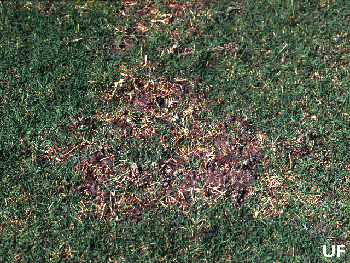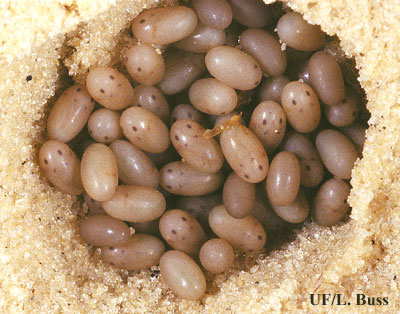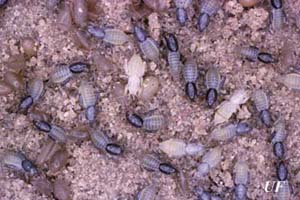 |
Mole cricket damage is primarily mechanical: tunneling through the soil near the surface,
severing the roots and uprooting the grass.
 |
Galleries are made mainly at night, apparently as the mole crickets are foraging in search of food, just below the soil surface. Galleries made in sandy soils are collapsed by rain. Heavy rains clear sandy areas of galleries, so that galleries appearing after a heavy rain are evidence of fresh mole cricket activity. Galleries in golf course greens are viewed as damage by golfers because these galleries can deflect the roll of a putted golf ball.
Mole crickets deposit their eggs in chambers hollowed out in the soil. Most chambers are found 4 to 12 inches below the soil surface, and are about the size of a golf ball. When a female mole cricket excavates a chamber, she lays one clutch of eggs in it. The number of eggs in the clutch varies among species, and varies with the physiological condition of individual females. When eggs have been laid in a chamber by a Neoscapteriscus mole cricket, the mother does not revisit it, and the entrance to the chamber closes. However, Gryllotalpa females revisit the chamber many times and take care of the eggs and hatchlings.
 |
So far as is known, mole cricket eggs of the 10 species mentioned in this knowledgebase incubate for about three weeks. Eggs take longer to incubate if they are subjected to a period of lower temperature. Mole cricket nymphs then hatch from the eggs. Nymphs look like adults but are very much smaller and they lack wings. It takes the nymphs many weeks of feeding and growing before they reach adult size, and they molt six to eight times as they grow.
 |
The month or months in which mole cricket eggs are laid varies among species and varies with latitude, and the same is true of the length of time that it takes mole cricket nymphs to develop. Some latitudinal variation is to be expected. For example, if the oviposition period of a mole cricket species is April–May in Florida, it is likely to be May–June in North Carolina, and October–November for the same species in northern Argentina, where seasons are six months out of phase. If the same mole cricket species occurs at intermediate latitudes, its oviposition period there may differ again. For these reasons, seasonality of mole crickets is described below for particular places, and it should not be expected that the seasonality will be identical at distant places.
Mole crickets are cold-blooded. They cannot move at freezing temperatures, so must remain dormant underground. The temperature must be still higher before they can fly.
Neoscapteriscus mole crickets caused problems first in Florida and Georgia because those are the states where they arrived first. Southern and tawny mole cricket populations continue to spread north and west, though spread of shortwinged mole cricket populations has not been noted. Colder temperatures ultimately will limit the spread of southern and tawny mole crickets to the north. There is no evidence that they will not spread farther west, though arid conditions may hinder them. In drought, mole crickets risk desiccation and seek moister locations or moister conditions deeper in the soil. They dig to the surface of flooded soil and move to higher ground.
Typically, adult mole crickets have wings and can fly. However, in some species such as the shortwinged mole cricket, the wings grow only to a small size, not nearly big enough for flight. In other species, such as the northern mole cricket, adults in some geographic areas do not develop large wings and cannot fly, though in other areas most or all of the adults develop full-sized wings. Mole cricket nymphs are wingless, but the larger nymphs have wing buds that will develop into wings at the final molt to the adult phase.
It may be that most flights by mole crickets are short, but a flight of 5 miles by a paint-marked mole cricket has been recorded. Furthermore, mole crickets arrived at lights on a fishing boat many miles off Florida’s east coast one night in March 1992, according to Harold Jones, Duval County extension agent, but the species of mole cricket and exact location were not recorded.
Mole crickets fly at night. Flights begin soon after sunset and end after little more than an hour in both the tawny mole cricket and southern mole cricket. They fly clumsily, though they dig very well in sandy soils. The body is covered by a dense mat of short setae, which seems to trap a layer of air around the body when a mole cricket is in water. Consequently, mole crickets are buoyant, not easily wetted, and they can swim well enough to reach the shore if they fall or land accidentally in canals and rivers.
Adult mole crickets have two pairs of wings (forewings and hind wings). Wings are covered by a network of veins that are tough tubes supporting the wing membranes. Spaces between the veins are called cells. Forewings of males and females differ slightly. Forewings of the males have a pair of large cells, the anterior of which has been described as harp-shaped. In fact it is shaped like a tiny outline map of Florida. The two cells together are called the stridulatory area. Females lack such large cells.
In males, one of the veins on each wing is modified with a line of tiny teeth to form a stridulatory file. This file is drawn across a scraper on the other wing as the wings close, and this makes a noise. Males make this noise — song — by opening and closing the wings. They amplify the song by widening the mouth of their gallery into a funnel shape, much like the speaker of a radio. The arrangement of the teeth in the stridulatory file differs from species to species, so the song differs from species to species. Males open and close the wings many times in rapid succession to sing, but sound is produced only as they close. Females do not sing. The songs are species-specific and unvarying. Tawny and southern mole cricket songs are continuous trills that differ in tone (carrier frequency, measured in kHz) and pulse rate (pulses/second). The song of the southern mole cricket is 2.7 kHz and 50 pulses/second, whereas that of the tawny mole cricket is 3.3 kHz and 130 pulses/second. The loudness of the songs varies but is typically about 70 dB at 15 cm from the source. The hearing organs of mole crickets are on the tibiae of the front legs.
Mole cricket males of most species sing to attract females of the same species. The UF/IFAS mole cricket program contracted with an electronics specialist to design sound emitters that synthesize these songs and are powered by a 12-volt battery. The emitters, now produced by a small electronics company, will play either of the two songs, and the volume is adjustable. When played at 105 dB, the emitter is much more attractive to mole crickets than when played at 70 dB. Females and some males sometimes are attracted in large numbers to the synthetic song of their own species.
Winged, adult insects of many species fly at night. A lot, but not all, are attracted to incandescent and fluorescent light. Moths flying around a porch light are a familiar sight. Mole crickets likewise fly at night and are attracted to fluorescent lights at gasoline stations and to floodlights on tennis courts. In general, the brighter the light, the more attractive it is. Investigation has shown that attractiveness of light for insects of various species varies by wavelength. Ultraviolet light is especially attractive for many insects. The wavelength most attractive for Neoscapteriscus mole crickets has not been investigated.
People who enjoy running may run 5 miles daily, whereas marathon runners may run farther, and some people do not run at all. We could estimate an average distance run daily for all members of a human population of a city by asking all the people to complete a survey form, tabulating the answers of those who bothered to complete the form and calculating the result. The resulting average, perhaps 0.25 mile, would not be very useful and would not be entirely accurate because some people did not bother to complete the form. The variance might be more interesting, for example, knowledge that 90 percent of the people who replied did not run at all and 0.05% ran 10 miles. If we had asked the right questions we might also find that none of the very young or very old ran 10 miles, that weather too hot or too wet made a difference, and that sick people did not run or only made a token effort.
We cannot easily do this same exercise for mole crickets because mole crickets do not complete survey forms. If we had plenty of funds, we could have hired several people to carry out a lengthy series of experiments over several years to gain the answers, but such funds have never been available. What we do know is that mole crickets cannot fly if the weather is too cold because their flight muscles will not work. We also know that when the air is very dry they tunnel into the soil to find moisture, so will not fly. By definition, they will not fly if they are too sick. It is likely that mole crickets younger than a certain age will not fly, much less likely that age alone will inhibit them from flight, but extremely likely that reproductive status will influence flight. They fly at night, especially in the early hours of the night, and the amount of moonlight probably makes a difference, as it seems to do so for nocturnally flying insects of numerous species.
The average distance flown, which we do not know, probably would be no more useful than the average distance run by a human population. The influence of previous flights is not clear: if a mole cricket flew last night, is it less or more likely to fly again tonight? We are left with extreme measurements: (a) on one occasion a marked mole cricket was captured in a trap 5 miles from the point where it was released, and (b) that mole crickets have turned up at lights on fishing boats at sea, dozens of miles from shore. These extreme measurements cannot be taken as typical. Perhaps mole crickets that happen to venture over the sea may be reluctant to touch down until they sense land below, so these may keep going until they drop from exhaustion.
The distance tunneled by mole crickets also is problematic. All we can say is that galleries of over 20 feet in total length have been found on the surface of sand without vegetation, and each of these 20 foot galleries appeared to have been made by one adult mole cricket. We suspect that these galleries would have been shorter if the sand had been vegetated, because the vegetation might have provided food and might have interfered mechanically with their tunneling activity.
Mole crickets are not strict vegetarians. Dissection of their guts to reveal the contents has shown that southern mole crickets feed largely on a diet of insects and other soil-inhabiting animals, and only to a slight extent on plants — perhaps when animal material is in short supply. In contrast, tawny and shortwinged mole crickets feed largely on plant material, and only to a slight extent on insects and other animals. Relatively very little damage is caused to plants by southern mole crickets as a consequence of this diet.
Since 1978, concentrated research has been conducted by University of Florida researchers in the following areas: basic research on life cycles, behavior, ecology, sampling methods, physiology, biochemistry, and taxonomy, biological control, resistant grass varieties, and chemical control.
The University of Florida sells color sheets depicting adult mole crickets, mole cricket life cycle, mole cricket damage (Turfgrass Insects Sheet 1) as well as photos of nematodes and a fungus attacking mole crickets (Beneficial Insects Sheet IV). The Entomology and Nematology Department offers additional color sheets that cover a wide range of beneficial and harmful insects. You can order these sheets through the UF/IFAS Extension Bookstore by calling (800) 226-1764 or order them online at http://ifasbooks.ufl.edu/.